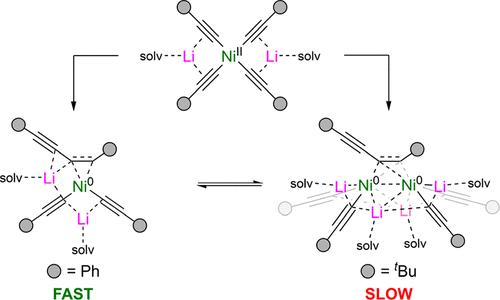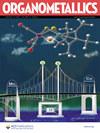研究同色镍酸锂乙酰络合物的还原消除和配体交换途径
IF 2.5
3区 化学
Q2 CHEMISTRY, INORGANIC & NUCLEAR
引用次数: 0
摘要
碱金属镍酸盐已被证明是一系列涉及极性有机金属的镍催化转化过程中的关键中间体,但对基本反应步骤的机理研究却十分有限。在此,我们评估了从均相镍酸锂 Li2NiII(C≡C-R)4(其中 R = Ph、tBu 或 SiMe3)还原消除生成 1,3-二炔的途径。我们发现,还原消除的速度随 R 取代基的不同而变化(R = Ph 时速度快,tBu 时速度慢),由此产生的 Li/Ni0 复合物(其中 1,3 二炔产物保持配位)可以采用不同的结构模式。对于 R = SiMe3 衍生物,已经确定了相互竞争的配体交换途径,并对其进行了光谱分析。本文章由计算机程序翻译,如有差异,请以英文原文为准。

Investigating Reductive Elimination and Ligand Exchange Pathways from Homoleptic Lithium Nickelate Acetylide Complexes
Alkali-metal nickelates have been shown to be key intermediates in a range of Ni-catalyzed transformations involving polar organometallics, but mechanistic studies into elementary reaction steps are limited. Herein, we assess reductive elimination pathways from homoleptic lithium nickelates, Li2NiII(C≡C–R)4, (where R = Ph, tBu, or SiMe3), to give 1,3-diynes. We find that the rate of reductive elimination varies depending on the R substituent (fast for R = Ph, slow for tBu), and that the resulting Li/Ni0 complex, in which the 1,3-diyne product remains coordinated, can adopt different structural motifs. For R = SiMe3 derivatives, competing ligand exchange pathways have been identified and spectroscopically interrogated.
求助全文
通过发布文献求助,成功后即可免费获取论文全文。
去求助
来源期刊

Organometallics
化学-无机化学与核化学
CiteScore
5.60
自引率
7.10%
发文量
382
审稿时长
1.7 months
期刊介绍:
Organometallics is the flagship journal of organometallic chemistry and records progress in one of the most active fields of science, bridging organic and inorganic chemistry. The journal publishes Articles, Communications, Reviews, and Tutorials (instructional overviews) that depict research on the synthesis, structure, bonding, chemical reactivity, and reaction mechanisms for a variety of applications, including catalyst design and catalytic processes; main-group, transition-metal, and lanthanide and actinide metal chemistry; synthetic aspects of polymer science and materials science; and bioorganometallic chemistry.
 求助内容:
求助内容: 应助结果提醒方式:
应助结果提醒方式:


